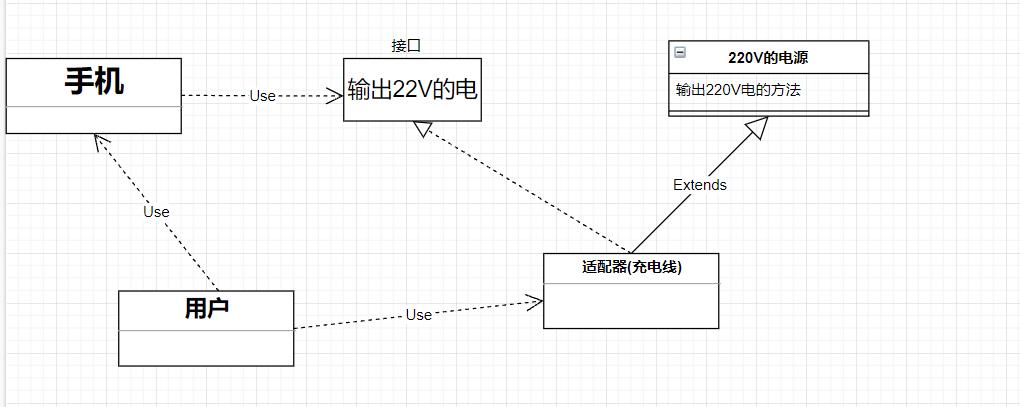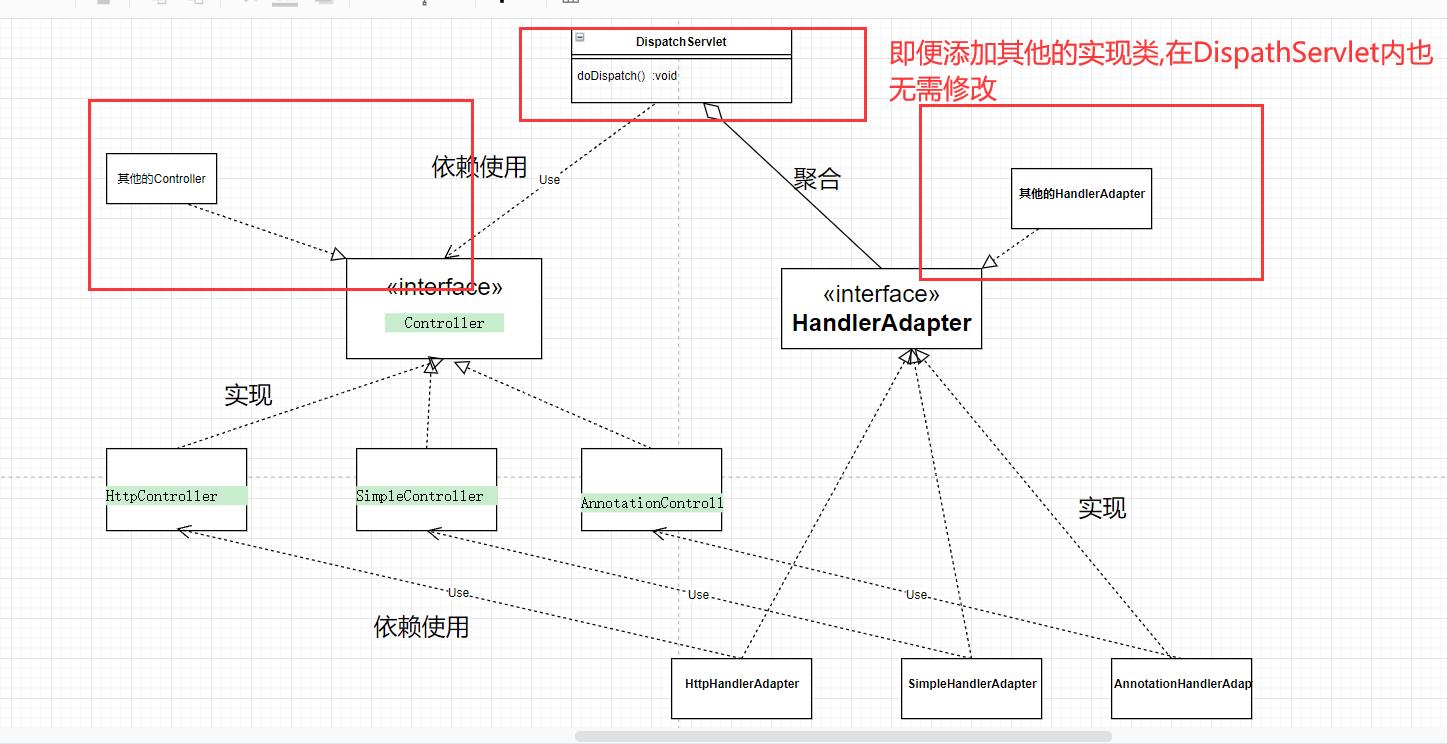尚硅谷设计模式学习 --- [类适配器模式对象适配器模式接口适配器模式]
Posted 小智RE0
tags:
篇首语:本文由小常识网(cha138.com)小编为大家整理,主要介绍了尚硅谷设计模式学习 --- [类适配器模式对象适配器模式接口适配器模式]相关的知识,希望对你有一定的参考价值。
🚀🚀🚀尚硅谷传送门==>B站尚硅谷Java设计模式
❤❤❤感谢尚硅谷❤❤❤
🕐🕐🕐最近开始计划学习一下设计模式了,加油!!!
适配器模式(Adapter Pattern);又称为包装器(Wrapper)
是将某个类的接口转换为 客户端需要的接口; 以达到兼容的效果;让类与类之间可以达到协同操作.
比如说生活中的多功能转换器;
从用户的角度看不到被适配者,是解耦的


🕐类适配器模式
基本原型 适配器 继承 被适配者 ; 实现 目标类的依赖接口;
由于Java的单继承;适配器直接去继承被适配者,使得出现局限性;且被适配的方法可由适配器去调用,安全度不高;但是继承带来的重写方法机制也是比较方便的.
案例 ;通过充电线给手机充电.
被适配者是电源220V电压 ; 目标是 5V电压; 适配器为充电中转线.

电源类Voltage220V
//电源类; (被适配者)
public class Voltage220V {
int src = 220;
//输出220伏特电压的;
public int out220V(){
System.out.println("电源输出=>" + src +"伏特电压");
return src;
}
}
适配接口Voltage22V
//交换电压接口; (适配接口)
public interface Voltage22V {
//输出22V的电压;
public int out22V();
}
适配器类AdapterVoltage
// (适配器)
public class AdapterVoltage extends Voltage220V implements Voltage22V{
//输出22V的电;
@Override
public int out22V() {
int srcV =out220V();
int dstV =srcV/10;
return dstV;
}
}
电话类TelePhone
//电话 依赖于适配接口;
public class TelePhone {
//充电;
public void charging(Voltage22V voltage22V){
if(voltage22V.out22V()==22){
System.out.println("22伏特,可以充电");
}else {
System.out.println("注意安全");
}
}
}
模拟客户端Client
//模拟客户端;
public class Client {
public static void main(String[] args) {
System.out.println("类适配器模式使用");
TelePhone tp=new TelePhone();
tp.charging(new AdapterVoltage());
}
}
测试
类适配器模式使用
电源输出=>220伏特电压
22伏特,可以充电
🕑对象适配器模式
根据合成复用原则,尽量不使用继承;
即对象适配器模式的原理就是
让 适配器 持有(聚合) 被适配者 ; 实现 目标类的依赖接口;

电源类Voltage220V
//电源类; (被适配者)
public class Voltage220V {
int src = 220;
//输出220伏特电压的;
public int out220V(){
System.out.println("电源输出=>" + src +"伏特电压");
return src;
}
}
适配接口Voltage22V
//交换电压接口; (适配接口)
public interface Voltage22V {
//输出22V的电压;
public int out22V();
}
适配器类AdapterVoltage ;注意不再是继承关系,而是聚合关系.
// (适配器)
public class AdapterVoltage implements Voltage22V{
//聚合关系;
private Voltage220V voltage220V;
//初始化;
public AdapterVoltage(Voltage220V voltage220V) {
this.voltage220V = voltage220V;
}
//输出22V的电;
@Override
public int out22V() {
int dstV=0;
if(null!=voltage220V){
//获取电源电压;
int srcV= voltage220V.out220V();
System.out.println("用了对象适配器模式");
dstV=srcV/10;
}
return dstV;
}
}
电话类TelePhone
//电话 依赖于适配接口;
public class TelePhone {
//充电;
public void charging(Voltage22V voltage22V){
if(voltage22V.out22V()==22){
System.out.println("22伏特,可以充电");
}else {
System.out.println("注意安全");
}
}
}
模拟客户端;
注意这里还要依赖(使用)电源;
//模拟客户端;
public class Client {
public static void main(String[] args) {
System.out.println("对象适配器模式使用");
TelePhone tp=new TelePhone();
tp.charging(new AdapterVoltage(new Voltage220V()));
}
}
测试
对象适配器模式使用
电源输出=>220伏特电压
用了对象适配器模式
22伏特,可以充电
🕒接口适配器模式
例如,一个类可能只需要某个接口中的其中几个方法,这时,可以让一个抽象类作为适配器,去实现接口;实现的方法内具体可以写成空的;即空方法;
然后让其他类去 使用 抽象类; 可以使用自己需要的方法.

案例
被适配的接口SrcInterface
//被适配者
public interface SrcInterface {
public abstract void methodA();
public abstract void methodB();
public abstract void methodC();
public abstract void methodD();
}
适配器;
//适配器;
public abstract class AdapterClass implements SrcInterface{
@Override
public void methodA() {
}
@Override
public void methodB() {
}
@Override
public void methodC() {
}
@Override
public void methodD() {
}
}
调用时仅适用需要的方法
public class Client {
public static void main(String[] args) {
//只调用自己需要的方法;
AdapterClass adapterClass=new AdapterClass(){
@Override
public void methodC() {
System.out.println("使用了方法C");
}
};
adapterClass.methodC();//使用了方法C
}
}
在springmvc中就用到了适配器模式;
比如说DispatcherServlet类;
当请求出现时,调用到 doDispatch 方法;
内部处理时,getHandler返回控制器;
getHandlerAdapter(mappedHandler.getHandler());返回适配器

通过适配器调用controller的方法;返回ModelAndView

可以注意到HandlerAdapter适配器实际上是个接口.

这个适配器有许多实现类;

模拟SpringMVC流程

适配器代替controller执行相应的方法
Controller控制层;
//Controller顶部接口;
public interface Controller {
}
class HttpController implements Controller {
public void doHttpHandler() {
System.out.println("HttpController");
}
}
class SimpleController implements Controller {
public void doSimplerHandler() {
System.out.println("SimpleController");
}
}
class AnnotationController implements Controller {
public void doAnnotationHandler() {
System.out.println("AnnotationController");
}
}
DispatchServlet 处理
public class DispatchServlet {
public static List<HandlerAdapter> handlerAdapters = new ArrayList<HandlerAdapter>();
public DispatchServlet() {
handlerAdapters.add(new AnnotationHandlerAdapter());
handlerAdapters.add(new HttpHandlerAdapter());
handlerAdapters.add(new SimpleHandlerAdapter());
}
public void doDispatch() {
// 此处模拟SpringMVC从request取handler的对象,
// 适配器可获取需要的Controller
HttpController controller = new HttpController();
// AnnotationController controller = new AnnotationController();
//SimpleController controller = new SimpleController();
// 获取对应适配器
HandlerAdapter adapter = getHandler(controller);
// 通过适配器执行对应的controller对应方法
adapter.handle(controller);
}
public HandlerAdapter getHandler(Controller controller) {
//遍历:根据得到的controller(handler), 返回对应适配器
for (HandlerAdapter adapter : this.handlerAdapters) {
if (adapter.supports(controller)) {
return adapter;
}
}
return null;
}
public static void main(String[] args) {
new DispatchServlet().doDispatch();
}
}
适配器层
//定义Adapter顶部接口
public interface HandlerAdapter {
public boolean supports(Object handler);
public void handle(Object handler);
}
//适配器类
class SimpleHandlerAdapter implements HandlerAdapter {
public void handle(Object handler) {
((SimpleController) handler).doSimplerHandler();
}
public boolean supports(Object handler) {
return (handler instanceof SimpleController);
}
}
class HttpHandlerAdapter implements HandlerAdapter {
public void handle(Object handler) {
((HttpController) handler).doHttpHandler();
}
public boolean supports(Object handler) {
return (handler instanceof HttpController);
}
}
class AnnotationHandlerAdapter implements HandlerAdapter {
public void handle(Object handler) {
((AnnotationController) handler).doAnnotationHandler();
}
public boolean supports(Object handler) {
return (handler instanceof AnnotationController);
}
}

以上是关于尚硅谷设计模式学习 --- [类适配器模式对象适配器模式接口适配器模式]的主要内容,如果未能解决你的问题,请参考以下文章